|
|
Post by another specialist on Sept 9, 2007 17:17:06 GMT
The western form (or Marl) was an altogether drabber animal, with a general mingling of black and pale brown above, underparts a dirty yellowish white and one dark band across its sides just in front of its thighs. It had a much wider range, extending from the southwest tip of western Australia as far north as Shark Bay.
It should be noted that recent revisions of marsupial taxonomy have included both the Eastern and Western Barred Bandicoots in the full species Perameles Bouganvilla, whose representatives survive on Bernier Island and one of the two Dorre Islands in Shark Bay.
The Encyclopedia of vanishing species.
By David Day
|
|
|
|
Post by another specialist on Sept 9, 2007 17:18:52 GMT
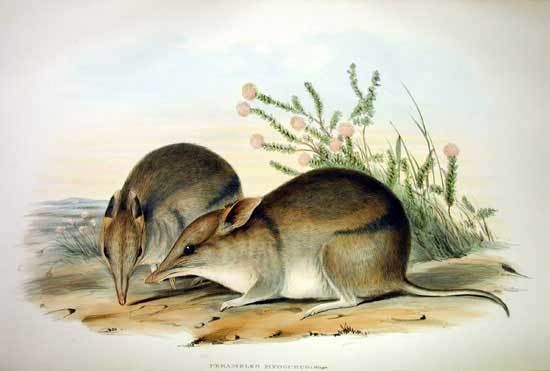 Australian Mammal Gould Print Images John Gould print image of the Western Barred Bandicoot Perameles bougainville (formerly known as Perameles myosurus) Photo from "Mammals of Australia", Vol. I Plate 10 Part of the 3 Volumes by John Gould, F.R.S. Published by the author, 26 Charlotte Street, Bedford Square, London, 1863 Reproduction Photo by Marnie Rawlinson, Cathy Accurso and Ken Walker © Museum Victoria www.museum.vic.gov.au/ |
|
|
|
Post by another specialist on Sept 9, 2007 17:20:08 GMT
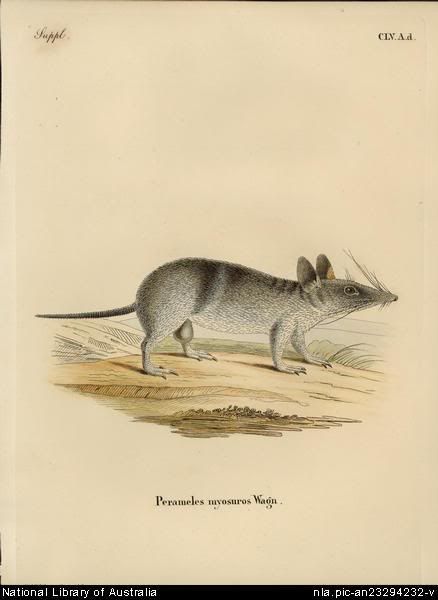 # Perameles myosuros Wagn. [now known as Perameles bougainville Quoy and Gaimard, 1824, common name western barred bandicoot] [picture]. # [ca. 1830] 1 print : engraving, hand col. ; plate mark 24.3 x 17.2 cm. on sheet 24.8 x 19.6 cm. # Part of European prints depicting Australian fauna in the nineteenth century [picture]. ca. 1830, ca. 1880. www.nla.gov.au/apps/cdview?pi=nla.pic-an23294232 |
|
|
|
Post by another specialist on Sept 9, 2007 17:21:25 GMT
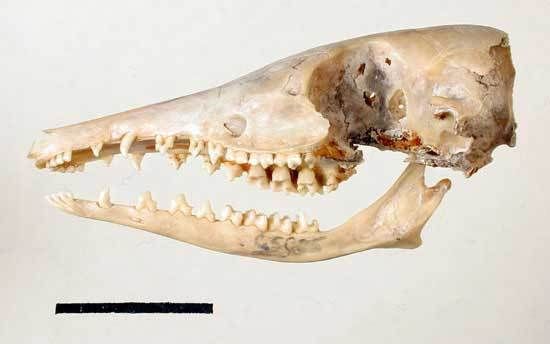 Head, showing skull and jaw side on, of a Western Barred Bandicoot Perameles bougainville Specimen Reg. No. C 5905. Locality: Western Australia Scale line equals 2cms. Photo by Marnie Rawlinson, Cathy Accurso and Ken Walker © Museum Victoria www.museum.vic.gov.au/bioinformatics/mammals/images/bougside.htm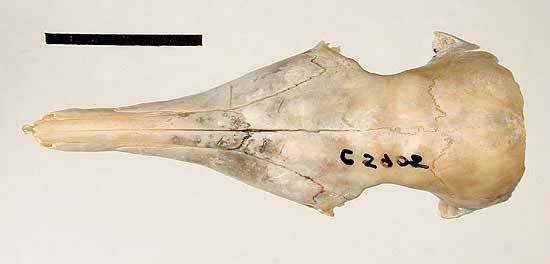 Exterior head, showing skull from above, of a Western Barred Bandicoot Perameles bougainville Specimen Reg. No. C 5905. Locality: Western Australia Scale line equals 2cms. Photo by Marnie Rawlinson, Cathy Accurso and Ken Walker © Museum Victoria 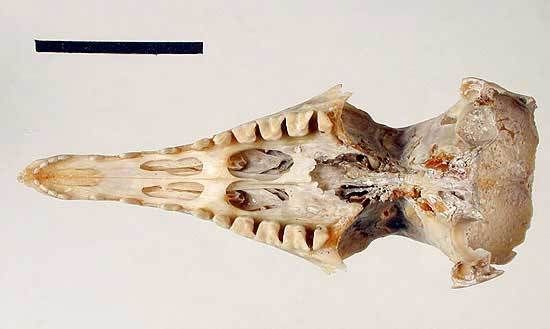 Interior head, showing skull from underneath, of a Western Barred Bandicoot Perameles bougainville Specimen Reg. No. C 5905. Locality: Western Australia Scale line equals 2cms. Photo by Marnie Rawlinson, Cathy Accurso and Ken Walker © Museum Victoria www.museum.vic.gov.au/bioinformatics/mammals/images/bougext.htmThis skull belongs to Perameles bougainville ssp. myosura |
|
|
|
Post by another specialist on Sept 9, 2007 17:26:13 GMT
|
|
|
|
Post by another specialist on Sept 9, 2007 17:32:12 GMT
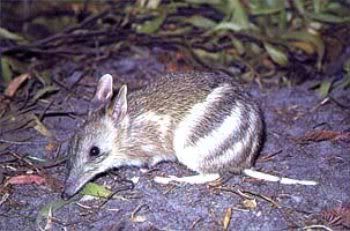 Perameles bougainville 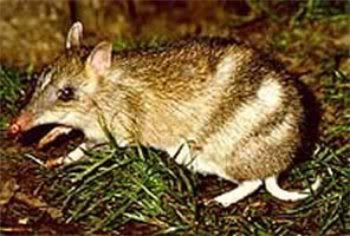 Perameles gunnii Here are sample pics of the two closest species including Perameles bougainville which supposedly Perameles bougainville ssp. myosura been lumpered with. The don't look anything like Perameles bougainville ssp. myosura they resemble more to Perameles bougainville ssp. fasciata |
|
|
|
Post by another specialist on Sept 9, 2007 18:19:51 GMT
Report on Threatened Shark Bay Marsupials, Western Barred Bandicoot Perameles bougainville bougainville, Burrowing Bettong Bettongia lesueur lesueur, Banded Hare-wallaby Lagostrophus fasciatus fasciatus, and Rufous Hare-wallabies Lagorchestes hirsutus bernieri and Lagorchestes hirsutus dorreae. Prepared for the Department of Environment and Heritage, Canberra. There are currently two subspecies recognised: P. b. bougainville on Bernier and Dorre Islands, and the extinct mainland form P. b. myosura (Maxwell et al. 1996). No genetic studies have been carried out on this species, and limited morphological data suggest that the current classification is appropriate (Short et al. 1998). www.cse.csiro.au/publications/2003/sbmarsupialsrecpln.pdf |
|
|
|
Post by another specialist on Sept 9, 2007 20:07:03 GMT
Western barred bandicoot The western barred bandicoot was an inhabitant of a wide variety of vegetation types within the southern arid and semi-arid zones of Australia. Gould (1863) described the range of P. myosurus in Western Australia as “inhabits the whole line of coast of the Swan River colony, but, so far as I can learn, is not found to the westward of the Darling range of hills. It resides in the densest scrub, thickets of the seedling Casuarinae being its favourite resort.” They lived in open saltbush, bluebush and Acacia plains, broken by sandhills and limestone outcrops in the western portion of central Australia (Jones 1923-25). The type specimen from Peron Peninsula was found at the foot of elevated dunes by Quoy and Gaimard in 1817 (Ride and Tyndale-Biscoe 1962). Gould (1863) thought that it was more common in the “interior”, in the country within the ranges, than in the area between the mountains and the sea in eastern and southern Australia. On the western slopes of New South Wales they were recorded from the stony ridges, which branch off from the ranges towards the Darling and Namoi Rivers. In South Australia they were found on the stony ranges and spurs, which ran down to the “bend of the Murray River”, and in the vast open plains near the head of St Vincent’s Gulf (Gould 1863). www.cse.csiro.au/publications/2003/sbmarsupialsrecpln.pdf |
|
|
|
Post by another specialist on Sept 9, 2007 20:18:47 GMT
The Shark Bay subspecies of the western barred bandicoot (Perameles bougainville bougainville) is one of Australia’s rarest mammals, currently surviving only as two wild populations on Bernier and Dorre Islands off Shark Bay, and as several small, captive populations on the mainland (Maxwell et al. 1996). The three original mainland subspecies, P. b. fasciata, P. b. notina and P. b. myosura are all extinct, due mainly to predation by cats and foxes, and modification of vegetation by rabbits and livestock (Maxwell et al. 1996). On semi-arid Bernier and Dorre Islands, wild P. b. bougainville mainly inhabits scrub associated with coastal sand dunes. The mainland captive population at Dryandra Nature Reserve used in this study inhabits open wandoo and powderbark woodland. The western barred bandicoot is the smallest bandicoot, with adults weighing 170–290 g (Friend and Burbidge 1995). www.publish.csiro.au/view/journals/dsp_journal_fulltext.cfm?nid=90&f=ZO05072 |
|
|
|
Post by another specialist on Sept 10, 2007 12:49:31 GMT
Victorian Mammal Images Mount of adult Western Barred Bandicoot Perameles bougainville 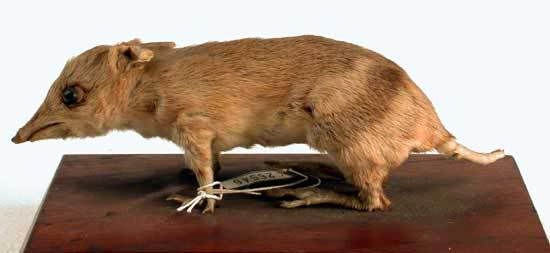 Photo & Copyright Museum Victoria www.museum.vic.gov.au/ |
|
|
|
Post by another specialist on Sept 10, 2007 12:53:24 GMT
Victorian Mammal Images Front foot from below, of a Western Barred Bandicoot Perameles bougainville  Specimen Reg. No. C 5903 Photo by Simon Hinkley and Ken Walker © Museum Victoria Hind feet from below, of a Western Barred Bandicoot Perameles bougainville 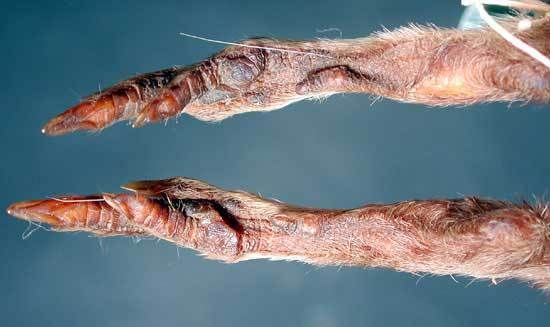 Specimen Reg. No. C 5905 Photo by Simon Hinkley and Ken Walker © Museum Victoria www.museum.vic.gov.au/ |
|
|
|
Post by another specialist on Jan 6, 2008 21:01:08 GMT
|
|
|
|
Post by another specialist on Feb 25, 2018 18:21:36 GMT
Moved back from formally recognized to extinct
Perameles bougainville ssp myosuros renamed as Perameles myosuros (Marl Bandicoot)
|
|
|
|
Post by another specialist on Feb 25, 2018 18:22:56 GMT
“We also re-evaluated the Western Barred Bandicoot (Perameles bougainville), a species now only found on islands near Shark Bay, and we found that it is in fact a complex of five distinct species. Four of these species had been named in the 1800s, but we described a new species from the Nullarbor region, the Butterfly Bandicoot or Nullarbor Barred Bandicoot (Perameles papillon).This is a new species that went extinct between 1920 and 1960, as a result of feral carnivores spreading west,” he said. Four of the eight bandicoots that once lived in in WA are now extinct: the Pig-footed Bandicoot (Chaeropus ecaudatus), the Desert Bandicoot (Perameles eremiana), the Marl Bandicoot (Perameles myosuros) and the Butterfly Bandicoot (Perameles papillon). The four that remain are the Quenda (Isoodon fusciventer, previously known as the Southern Brown Bandicoot), Northern Brown Bandicoot (Isoodon macrourus), Golden Bandicoot (Isoodon auratus), and the Little Marl (Perameles bougainville), which was previously known as the Western Barred Bandicoot museum.wa.gov.au/about/latest-news/new-research-tracks-evolution-bilbies-and-bandicoots-new-species-discovered |
|
|
|
Post by surroundx on Mar 5, 2018 11:40:46 GMT
|
|